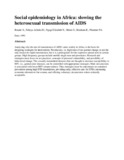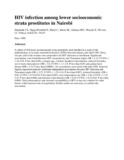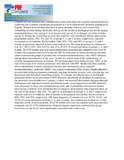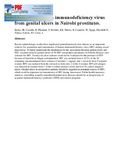Search
Now showing items 11-20 of 21
Social epidemiology in Africa: slowing the heterosexual transmission of AIDS
(1991)
Analyzing why the rate of transmission of AIDS varies widely in Africa is the basis for designing strategies for intervention. Promiscuity, i.e. high rates of sex partner change, is not the only reason for rapid transmission, ...
Epidemiologic evidence for the development of serovar-specific immunity after gonococcal infection
(1989)
We tested the hypothesis that strain-specific immunity occurs after gonococcal infection in a longitudinal study of 227 prostitutes resident in one small community who experienced frequent gonococcal infections. Women were ...
HIV infection among lower socioeconomic strata prostitutes in Nairobi
(1990)
A cohort of 418 lower socioeconomic strata prostitutes were enrolled in a study of the epidemiology of sexually transmitted diseases (STDs) between January and April 1985. Sixty-two per cent of the women were seropositive ...
Prevention of transmission of human immunodeficiency virus in Africa: effectiveness of condom promotion and health education among prostitutes
(1988)
Condom use was assessed after a programme of education about the acquired immunodeficiency syndrome and a condom distribution programme in a well-characterised prostitute population in Nairobi. Women received their education ...
A review of HIV-1 in Africa
(1988)
As the AIDS epidemic reaches a dramatic stage of development, the time for African countries to establish effective control programs has come. The history of AIDS in Africa is different from that other regions of the world. ...
Isolation of human immunodeficiency virus from genital ulcers in Nairobi prostitutes.
(1989)
Recent epidemiologic studies have implicated genital/anorectal ulcer disease as an important cofactor for acquisition and transmission of human immunodeficiency virus (HIV) during sexual intercourse. To better understand ...
Trends in HIV -1 Incidence in a Cohort of Prostitutes in Kenya: Implications for HIV -1 Vaccine Efficacy Trials
(2000)
Background: Accurate predictions of HIV-I incidence in potential study populations are essential for designing HIV-I vaccine efficacy trials. Lillie information is available on the estimated incidence of HIV-I in such ...







